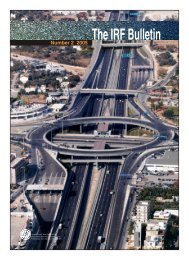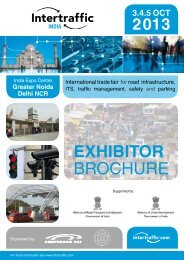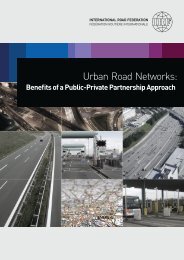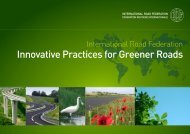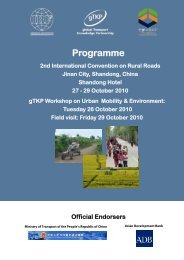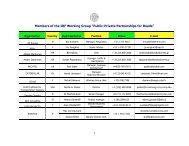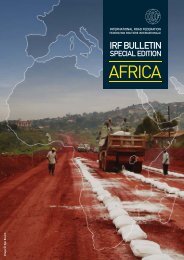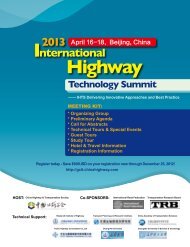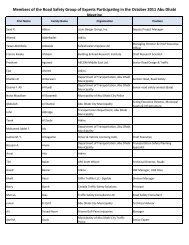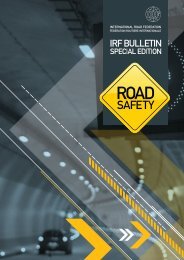TRANSPORT
TRANSPORT
TRANSPORT
- No tags were found...
Create successful ePaper yourself
Turn your PDF publications into a flip-book with our unique Google optimized e-Paper software.
ROAD SAFETY<br />
Wildlife crossing roads in rural areas also endanger drivers<br />
and passengers, in addition to the animals themselves.<br />
Recent efforts to improve rural road safety are<br />
encouraging<br />
Efforts are ongoing at national and regional levels to<br />
improve rural road safety in Africa. For instance, fences<br />
have been constructed and are regularly maintained along<br />
roads such as the N4, which links Maputo in Mozambique<br />
with Witbank in South Africa, to prevent animals from<br />
entering the carriageway. Overhead bridges have also been<br />
constructed to facilitate the movement of pedestrians and,<br />
in some cases, cattle. Furthermore, telephones, linked with<br />
ambulance and emergency services, and other relevant<br />
authorities, have been installed along the N4. In Ethiopia,<br />
road safety consciousness in rural areas is increasing as a<br />
result of targeted awareness raising campaigns. Regional<br />
transport bureaus and traffic police are also controlling<br />
excess loading of public transport vehicles.<br />
At the regional level, the Economic Commission for Africa<br />
(ECA) has spearheaded efforts to mainstream the special<br />
needs of rural areas in Africa’s road safety agenda. In that<br />
regard, the Commission and several partners organised<br />
the African Road Safety Conference in Accra, Ghana, in<br />
February 2007, during which the specificities of rural road<br />
safety were extensively discussed. The Conference noted<br />
that road safety dimensions in rural areas were different<br />
from those in urban areas. It recommended that First Aid<br />
training be provided to rural drivers and villagers; that<br />
community data collection systems should be introduced;<br />
mixed transport regulated; and support provided for<br />
research on issues related to rural transport safety.<br />
ECA has developed a framework for monitoring and<br />
evaluating progress in implementing the recommendations<br />
of the Accra Conference. This framework was adopted<br />
at a seminar organised in 2009 by the Commission, in<br />
collaboration with the FIA Foundation for the Automobile<br />
and Society. It provides the following performance<br />
indicators for measuring progress in rural transport safety:<br />
percentage (%) reduction of rural road users involved in<br />
fatalities; % reduction in animal strikes; and % of countries<br />
with community data collection systems.<br />
But road safety measures should be comprehensive<br />
and should not threaten the livelihoods of the rural<br />
population<br />
Strict enforcement of national road safety rules and<br />
regulations would adversely affect mobility in rural areas.<br />
For instance, applying roadworthiness standards would<br />
disqualify most public transport vehicles in rural areas from<br />
operating because they are likely to be below national<br />
standards. However, taking these vehicles off the road<br />
would further compound the mobility problem in rural<br />
areas, as the supply of transport services is already quite<br />
low. Therefore, enforcing roadworthiness standards in rural<br />
areas would have a negative impact on the livelihoods of the<br />
population if this were not accompanied by other measures<br />
such as improving the condition of the roads with a view to<br />
attracting better vehicles. Similarly, preventing overloading<br />
of vehicles would severely constrain rural mobility if the<br />
supply of transport services were not increased.<br />
Overall, given the choice between mobility and safety,<br />
most rural dwellers will chose mobility, which in most cases<br />
is necessary for their livelihoods and even survival. This is<br />
illustrated by their willingness to take desperate measures<br />
such as sitting on the roofs of moving vehicles or sharing<br />
the same space with animals. Therefore, for a rural road<br />
safety programme to be effective and accepted by local<br />
communities, it should be comprehensive and not at the<br />
expense of mobility. This calls for research into developing<br />
methodologies for determining the optimal mix of road<br />
safety measures in rural areas – one that minimises the<br />
negative impacts on mobility. Such research should take<br />
into consideration factors such as the demand and supply<br />
of transport services, the availability of alternative modes<br />
of transport and the state of road infrastructure.<br />
16<br />
| IRF BULLETIN SPECIAL EDITION: RURAL <strong>TRANSPORT</strong>, VOLUME-2



